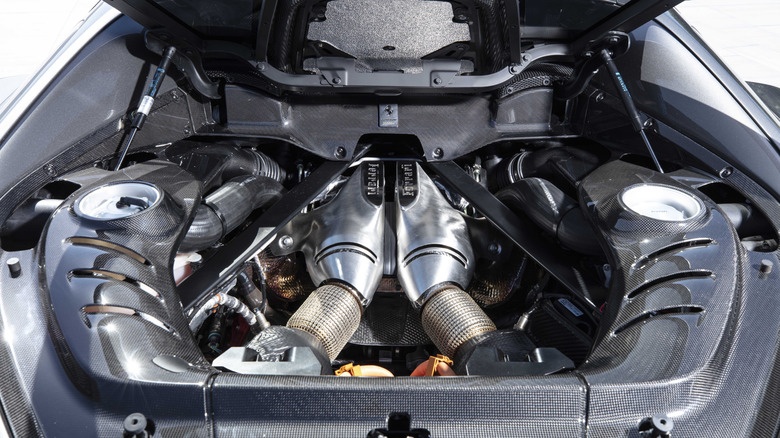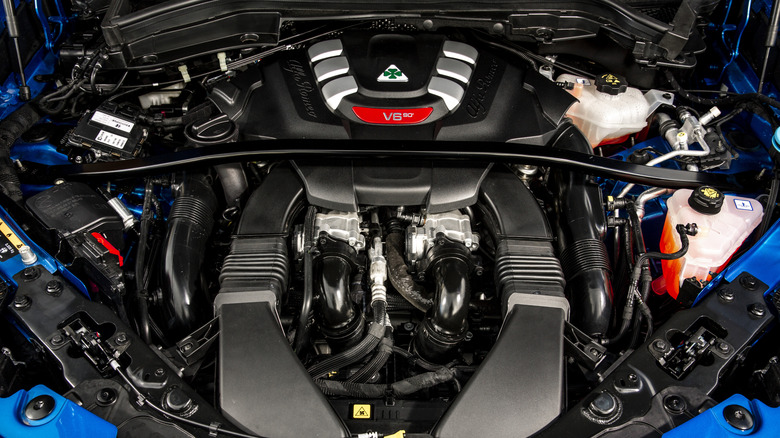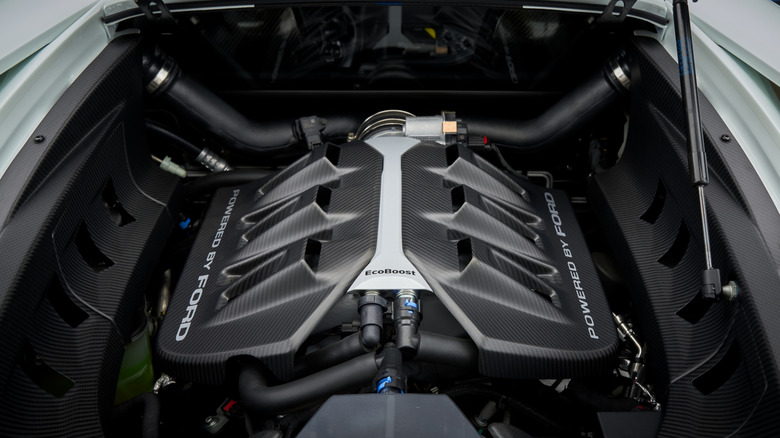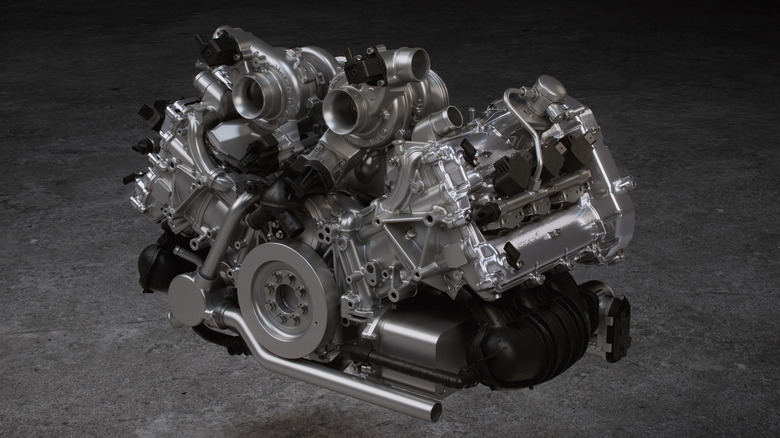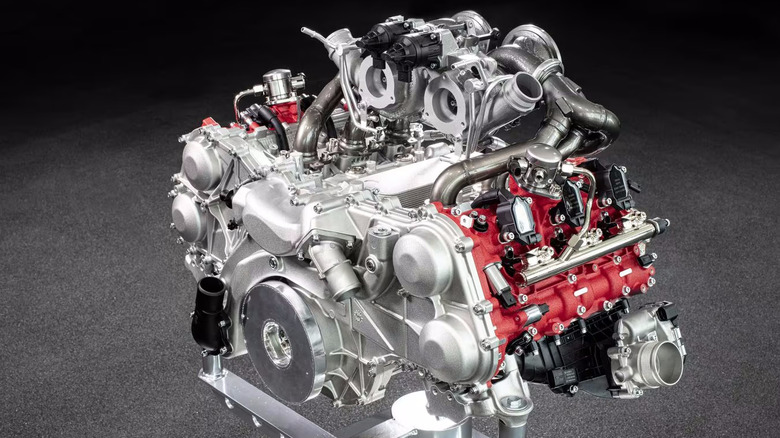These V6 Engines Put Out More Horsepower Than An LS1 V8
There's no single reason why the LS V8 engine is so special. Instead, it's a combination of many things: LS engines are easily modifiable and have a reputation for reliability, making them excellent choices for all kinds of modified car projects. They're also lightweight by design, and thanks to their popularity, they're readily available to buy both in used form and as new, race-ready crate engines direct from Chevy.
The LS1 was the first LS V8 to launch, replacing the second generation LT1 engine, and it made its debut in the 1997 Corvette C5. Initially, it was rated for 345 horsepower, but later iterations of the C5 Corvette boosted that figure to 350 horsepower. As well as being made available for American buyers, the LS1 was also handed over to GM's Australian performance car division, who further tweaked the engine to produce an official output of 382 horsepower. Tuners such as Callaway further increased its output to more than 400 horsepower.
Those were impressive figures for the era, but they're not quite as groundbreaking today. In fact, a number of modern V6 engines comfortably beat the LS1 V8 in the horsepower wars. One carmaker even produced a V6 back in the '90s that eclipsed the LS1's output, although it wasn't anywhere near as attainably priced as Chevy's legendary V8.
Alfa Romeo 2.9-liter V6 - 540 horsepower
Built for the Giulia Quadrifoglio and Stelvio Quadrifoglio, Alfa Romeo's 2.9-liter twin-turbo V6 engine produced 505 horsepower in its standard form and up to 540 horsepower in the ultra-limited Giulia GTA. The final orders for the pair of Quadrifoglio models were taken in 2024, with Alfa offering both cars in a Super Sport limited edition to see off their production runs. It marked the end of a relatively short lifespan for the V6 engine, which first launched for the 2017 model year.
The engine was designed by ex-Ferrari engineers and shares some of its dimensions with the Ferrari F154 V8, but it isn't just a Ferrari V8 with two cylinders removed. It features several specific systems, including a cylinder deactivation system to help it meet fuel efficiency regulations. In certain circumstances, one bank of cylinders can deactivate to effectively leave the engine running on three cylinders. In an interview with Auto Tecnica, lead engineer Gianluca Pivetti reported that the system boosted fuel efficiency by 7%.
When designing the engine's components, Pivetti used plenty of expertise gleaned from his years at Ferrari. Using gas nitriding to toughen key engine components like the crankshaft was a technique borrowed straight from the Prancing Horse, while the engine's crankcase design was borrowed from Ferrari's V8 engine to keep development costs down. The result is an engine that takes heavy inspiration from Ferrari, but nonetheless remains distinct from the F154.
Ford 3.5-liter EcoBoost V6 - 647 horsepower
Building a high-powered engine can only get you so far. For proper boundary-pushing performance, an engine also needs to be lightweight. It's one reason why tuners are so fond of the LS engine, and it's also why Ford used aluminum for many of the components of the 3.5-liter twin-turbo EcoBoost V6 that powered the second generation GT.
The engine block, pistons, heads, and intake manifold were all made out of aluminum, and combined with the car's carbon fiber monocoque, that resulted in the GT having a dry weight of 3,053 pounds. With the V6's 647 ponies, that left the car capable of a top speed of 216 mph and 0-60 mph in under three seconds.
We put the Ford GT through its paces in a 2017 road and closed-circuit drive and found its talents shone through in both environments. It was most at home on the track, where the V6 "scream[ed] like an enraged banshee," with its twin turbochargers making a racket as they spooled up to deliver peak power. Unfortunately, with only 1,000 examples produced, many enthusiasts will never get the chance to hear a GT at full throttle in person, never mind being able to get behind the wheel and test it out for themselves.
McLaren 3.0-liter M630 V6 - 577 horsepower
At the heart of the McLaren Artura sits an all-new V6 engine that was designed specifically for the car. The brand's official designation for the engine is the M630, and it's officially rated at 577 horsepower. In the Artura, it's complemented by an electric motor, giving the car a combined power output of 671 horsepower. The M630 engine is designed to be both as powerful and as efficient as possible — the latter being particularly important for meeting increasingly stringent emissions regulations in key markets like Europe.
The engine's two cylinder banks are arranged at a 120 degree V-angle, which gives it a lower center of gravity than a traditional V6 design. It also means that the engine's two turbochargers can just about be squeezed between the two banks, reducing the overall footprint of the engine. Twin turbochargers are sometimes employed to reduce turbo lag, but thanks to the instant response of the accompanying electric motor, any momentary shortfall in the V6's torque delivery is offset by electric power.
The Artura is the first series-production hybrid McLaren – the earlier P1 was strictly limited to 375 examples — and it's also the first series-production McLaren of the modern era to feature a V6 rather than a V8. It might be very different to its predecessors, but after spending time with the car on the track and on winding Spanish roads, we came away convinced that it was just as appealing as ever.
Ferrari 3.0-liter F163 V6 - 654 horsepower
Ferrari's hybrid V6 supercar debuted a few months before the McLaren Artura, but it features a similar design. Like the McLaren, the F163 V6 features a 120-degree V-angle and a pair of turbochargers housed in the middle of the two banks of cylinders. According to Ferrari, the F163 was designed to be a "little V12," delivering a similar soundtrack to the brand's legendary 12-cylinder engines without compromising on the packaging and efficiency gains that come with losing six of its cylinders.
The first car to feature the F163 V6 engine is the 296 GTB, which packs an electric motor and battery alongside its ICE powerplant. The electric and combustion motors combined give the car a total output of 819 horsepower. While the F163 V6 engine itself is a clean-sheet design, the 296 GTB's electric motor and battery took design inspiration from the brand's Formula 1 car, which also uses a hybrid V6 powertrain.
Jaguar 3.5-liter V6 - 542 horsepower
While most V6 engines with LS1 V8-beating power were produced this century, a handful of high-powered six-cylinder engines hit the market long before the LS1 was unveiled. The 3.5-liter twin-turbocharged V6 engine that powered the Jaguar XJ220 was launched in 1992 and boasted 542 horsepower. It was a deeply controversial engine, since the XJ220 had originally been shown off in prototype form with a V12 engine and all-wheel drive.
The switch from a V12 to a V6 was seen as a downgrade by many, but the original V12 had never been intended for production — it was a leftover development engine sourced from Cosworth, primarily as a means to make Jaguar's concept car look more exciting. The V6 engine was the more practical, cost-effective choice, and it didn't need anywhere near as much development work, as it was borrowed from the MG Metro 6R4 rally car.
The eventual XJ220 production car was very different to the original concept and also very expensive, costing £470,000, or around $867,000 at the time. As a result, only 275 examples were built, including an ultra-limited XJ220 S variant that boosted the V6's power output to a staggering 690 horsepower.
